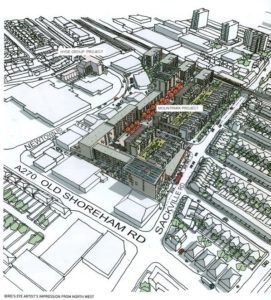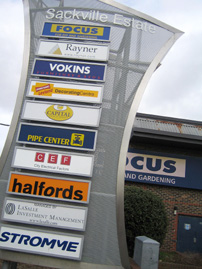Developer Mountpark’s initial proposals to regenerate the Sackville Trading Estate and the coal yard were the main topic of discussion at Hove Station Neighbourhood Forum’s Have Your Say Day yesterday (Saturday 18 March).
The plans, which are still at the design stage, are part of a bigger regeneration initiative.
The area covered stretches from the Sackville Estate and the old coal yard north of Hove Station to Newtown Road and Goldstone Lane where work by the Hyde Group is already under way.
Changes in School Road, the other side of Aldrington Station, are also being looked at by the neighbourhood forum although they fall outside the area – known as Development Area 6 – defined by the City Plan.
Mountpark’s managing director of UK operations, Philip O’Callaghan, a Hove resident, said that he wanted to replace tired single-storey buildings with 70,000 sq ft of offices and cultural space offering high-density employment as well as 600 new homes.
Mr O’Callaghan said that the scheme would boost the labour market with 475 jobs, plus 100 in construction, 400 in supplying the area and £1.5 million a year in council tax. There would also be a significant developer contribution.
He said: “This will be a catalyst towards wider regeneration in the Hove Station area and the larger Brighton and Hove area as well.”

Monica Coffey, partner at Stockwool Architects, explained that one challenge of the area was that it was built on several different levels, particularly around Hove station.
She said that the designs were intended to create better connectivity and more access points.
The initial proposals suggest that pedestrians would have access to the site at the top and bottom and through a new square over the site of the cultural industries space.
There would be a new street which Ms Coffey thinks is key to building community. It would be an 18m-wide residential street with individual front doors and entrances to the taller blocks of flats, making it a safe, shared public space.
Early indications suggest that “pavilion” buildings would be in the south of the development with southerly views. Parking would be on the west side – the Sackville Road – alongside more homes.
At the top of the development there would be offices and a food store in a square with a northern staircase to address the 6ft change in level.
The plans include two-storey family homes with a garden terrace over the parking area.

Karen Macmillan, who lives south of Hove Station, asked Ms Coffey about trees and said: “The new north to south street is just a wind tunnel. It is not very imaginative.”
But Ms MacMillan supports the plan to build more housing and hopes it will be proper mixed housing. She said: “The volume of housing will change the area. Hove Park is going to be rammed but thank God we have it. I’d rather we built housing than had unused industrial units.”
Former councillor Christopher Hawtree said: “I am broadly in favour of the development. We need to look at the whole area to get something coherent. It needs a lot of lateral thinking.
“We need buildings for employment so that the place does not become another dormitory town. We have got to have people working.”
When asked about the Neighbourhood Plan, Mr Hawtree said: “It is generally a good idea. It would be good to have a plan that people generally agree with. Of course, the devil is in the detail. A mixture of terraces and flats. Developers tend to wriggle out of affordable housing. It should be viable. We are in the most expensive part of the country. More will emerge. We will wait and see.”
John Barker, of Old Shoreham Road, was concerned about traffic and road access because Sackville Road is already congested and has multiple traffic lights.
He works in the education sector and was also worried about the impact of the development on school places as people move into the area.

Mr Barker said that primary schools in the area are already short of places, Hove Park and Blatchington Mill secondary schools were full and children are displaced from Dorothy Stringer and Varndean.
However, the need for more housing was clear. Liz Hobden, head of planning for Brighton and Hove City Council, said that there were 24,000 people on the waiting list for housing and current developments would not meet even half of the housing need in the city.
She said: “The council has a target of 40 per cent affordable housing in each development but the council can’t insist on this because it might make developers go away.”
Matsim’s development known as Hove Gardens around Hove Station has been under consideration by the council for nine months.
Ms Hobden said: “We are at an impasse about the viability appraisal. The district valuer is looking for evidence. We hope to report back about what level of contribution is fair. We aim to continue to work with the developer.”
The role of the district valuer includes analysing costs and ruling about how much affordable housing a developer can afford and what financial payments they should make for local infrastructure and services.
Ms Hobden explained that it was more expensive for developers to develop brownfield sites than greenfield ones and this often resulted in lower developer contributions and less affordable housing.








Comments 2